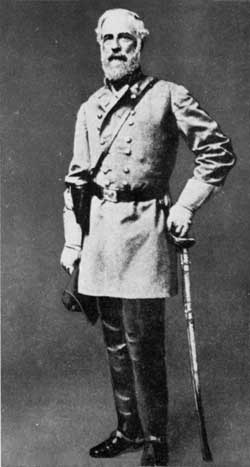|
MANASSAS National Battlefield Park |
 |
Preliminary Operations to Second Manassas
 Gen. Robert E. Lee, in command of the Army of Northern Virginia. Courtesy National Archives. |
McClellan's failure to move against Johnston resulted in a restive public and press. Richmond, rather than Centreville, now became the immediate Federal objective. Learning of an anticipated movement against Richmond via Urbanna, Johnston, on March 9, fell back from Centreville to take up a position south of the Rappahannock, with his right resting at Fredericksburg and his left at Culpeper Court House. This forced a modification of McClellan's original plan. He thereupon decided to make the movement by water to Fortress Monroe and from there advance of the Peninsula upon Richmond.
On March 17, the Federal army embarked from Alexandria. McClellan had anticipated the use of a force of about 155,000 men. The brilliant operations of "Stonewall" Jackson in the Shenandoah Valley during the next 3 months, however, so alarmed President Lincoln as to cause him to immobilize nearly 40,000 of McDowell's troops at Fredericksburg to secure the defenses of Washington. This, together with the detention of Banks' expected reinforcements in the Valley, reduced McClellan's force to approximately 100,000, thereby materially minimizing his chances of success. Seldom has so small a force as that of Jackson (approximately 16,000) so largely influenced the final outcome of a major military operation.
Johnston, in the meantime, had reinforced Magruder at Yorktown. On May 4 the town was evacuated, and the next day a successful rear-guard action was fought at Williamsburg, covering the Confederate withdrawal to Richmond. The Federal army followed by land and water to White House on the Pamunkey where, on May 16, McClellan set up his headquarters. The next day the Federal forces resumed their advance on Richmond.
Gathering a force of some 63,000 men, Johnston then determined to attack. On May 31, in the Battle of Seven Pines, followed by the Battle of Fair Oaks the next day, the Confederates were repulsed, and Johnston was severely wounded. The command of the Army of Northern Virginia now devolved upon Robert E. Lee, a command that he was not to relinquish until the end of the war. Within 2 weeks the defenses of Richmond had been strengthened and the morale of the troops greatly improved.
By June 25, Lee had assembled a force of about 90,000 men, including Jackson's victorious command from the Valley. The next day he launched his great counteroffensive. In a series of desperately contested operations, known as the Seven Days' Battles before Richmond, McClellan was forced back upon Harrison's Landing on the James. Though the campaign was costly in Confederate casualties, Lee saved Richmond and cloaked his army with a sense of invincibility.

|

|
|
Last Modified: Sat, Apr 7 2001 10:00:00 am PDT |


